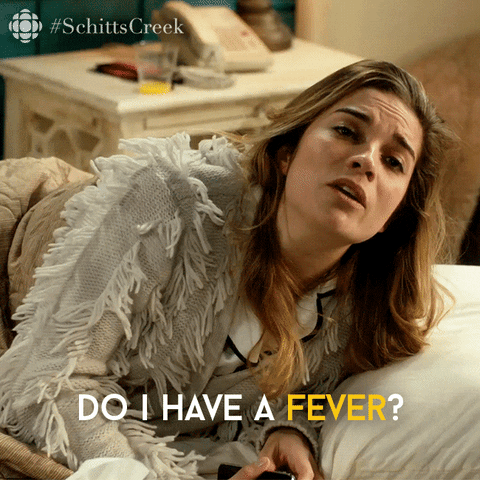Our current monsoon of illness is pure chaos. Pediatric offices are bulging with kids who need to be seen and phones are ringing off the hook, while staff is dealing with illness and sick kids of their own. I’ve seen hundreds of exhausted, stressed and worried parents who have had a sick kid in their house for weeks, with no end in sight.
And, it’s only November.
One of the most common reasons parents are calling or coming to the office is FEVER. Let’s face it, fever freaks parents out. Fever makes kids behave strangely, look pathetic and cause anxiety in even the most experienced parents. Since the cold and flu season is just ramping up (yikes!), now is the time to refresh and re-learn what we know about fever.
First, A Few Fever Facts
A fever is a temporary rise in body temperature due to stress or illness. Most consider a fever to be 100.4F degrees or higher, although kids can be ill or have infections without this rise in temperature.
Fever is a symptom of illness, not a disease. With very specific exceptions, fever is a normal, healthy way for the body to fight common infections. Bacteria and viruses that attack our bodies love normal body temperature, but cannot successfully replicate in hotter conditions. Fever reflects a robust immune system’s defense against these pathogenic attackers. The bacteria and viruses are the enemy, not the fever they cause.
It’s not your imagination - Fevers are worse at night. Our body systems follow a circadian rhythm. During the day, our level of cortisol (a stress hormone) is typically higher, slightly suppressing the work of the infection-fighting cells in our blood. At night, when cortisol levels drop, the immune system ramps up. When our immune system is working harder, higher fevers and more symptoms of illness is a result of this work.
Top 10 Fever FAQs
1. What is the best way to take a child’s temperature?
For healthy babies under three months of age, it’s okay to use an armpit thermometer to quickly screen for a fever. A simple digital thermometer will work, and you may have gotten one from the hospital where you delivered. If a baby’s armpit temp is 99F degrees or higher, then a rectal temperature must be done to confirm your baby’s temperature. (Here’s a how-to video from Mount Sinai.) If the rectal temperature is 100.4F degrees or higher, call your pediatrician immediately or go to your nearest emergency room.
For kids over three months, an armpit thermometer remains a good option for screening. If the temperature is over 99F degrees, you can confirm a fever with a rectal or forehead (temporal artery) thermometer.
After six months of age, ear thermometers become an option, but can have some variability in accuracy. You’ll have the best chance of getting a correct temp by gently pulling your child’s ear up and back, while aiming the tip of the ear probe between the opposite eye and ear. Check both ears, and assume the higher temperature is correct.
Over the age of four years, an oral thermometer is thought to be the most accurate. Make sure your child has not consumed anything cold or hot for at least 15 minutes before taking a temperature. Ear and forehead thermometers are also great options for this age.
In our office, we use a simple digital thermometer to get rectal temperatures on our infants and a Braun Thermoscan for older kids. #notsponsored
Warning: Forehead fever strips and pacifier thermometers are not very accurate, so save your money.
2. Is it true that the higher the fever, the more I should worry?
Although a high fever may indicate more serious illness in an adult, this is not the case for young kids. A young child’s immune system is always on high alert, and any sign of illness can result in a significant immune response. However, as a child gets older and the immune system gets more refined, it becomes less reactive. That’s why young kids get fevers with a common cold, while most adults do not.
Regardless of the actual numerical value, look for signs of serious illness in your child. In my office, I see kids running and playing with really high temperatures. I also see children who look sluggish and sad with a reasonably mild fever. Observe the amount of discomfort, level of activity and ability to maintain adequate hydration. Those symptoms are more important than the number itself.
Of note, we are currently seeing LOTS of influenza A in our area. It’s not uncommon to see 105F degree fevers for multiple days with this viral illness. The best protection against significant illness and hospitalization from the flu is the influenza vaccine. Be sure your child is up-to-date.
3. When do I take my child to the doctor for a fever?
Over three months of age, most fever can be safely treated at home with fever reducing medication, hydration and patience. The fever caused by most viral illnesses of childhood are typically seen at the beginning of an illness, associated with other symptoms and last about 72 hours. But, there are few instances when pediatricians definitely want to see your child with fever.
It’s time to go to the doctor when:
your child is less than three months old and has a fever of 100.4F or greater
your child has had a fever for three consecutive days or longer
the fever is not coming down with fever reducing medication
your child is also showing other signs of pain or discomfort, like a sore throat or ear pain
if you are concerned about dehydration or excessive fatigue
A pediatrician's job is to examine kids when parents are concerned. If you are worried, please call your pediatrician’s office. We are here to help you determine when you need to bring them in.
4. What “number” on the thermometer means an ER visit?
Over the age of three months, there is no number on a thermometer that requires a trip to the emergency department. Nope, not even 105F degrees.
It’s never wrong to seek help when you’re worried about your child, but no one wants to sit in the ER needlessly for hours. If your child gets a high temp, grab the fever reducer (see FAQ #6) and try to lower the fever at home before jumping in the car.
Pediatricians are always going to be more worried about fever for multiple days in a row (more than five) than a kiddo with a brief 105F temperature. And, we are going to be more worried about a kid who is too sleepy, not drinking or in pain — no matter the number on the thermometer.
If there has been no change in your child’s temperature after an hour of offering a weight-based dose of medication, reach out to your pediatrician for advice.
5. Isn’t it true that fever helps the body fight infection, so we shouldn’t use fever reducer?
The goal of offering fever reducing medication is NOT to get a high temperature back to “normal.” Fever reducers, like acetaminophen and ibuprofen, are simply medications to make your child feel better and might decrease the risk of dehydration.
As an aside, if you are coming to the pediatrician’s office because your child has a fever and her or she is uncomfortable, please give your child a fever reducing medication BEFORE coming to the office.
The doctor doesn’t have to “see the fever.” We believe you. Plus, a comfortable child is much easier to examine. And a good exam will often determine the cause of the fever, allowing for accurate treatment.
6. What’s the difference between ibuprofen and acetaminophen? Which one should I use?
Fever reducers do NOT treat infection or cure a fever. The goal of these medications is to simply make your child feel better.
Acetaminophen (Tylenol) helps with pain and fever. This medication may be given to infants over the age of three months, sooner if approved by your healthcare provider. It is available in various forms. Acetaminophen keeps working in the body for 4-6 hours after administration.
Ibuprofen (Advil, Motrin) helps pain, fever and swelling. Ibuprofen can be given to infants over the age of six months and is taken by mouth. The duration of action for ibuprofen is 6-8 hours.
Medications should be dosed according to your child’s weight, not age. If you feel that your child needs medication, give the correct dose. Here is a weight-based dosing chart for acetaminophen and ibuprofen. Learn more about safely using these meds in FAQ #7.
Fever reducer tips:
It’s not uncommon during the course of an illness for the temperature to rise near the end of the dosing interval.
These medications may take up to an hour to start working.
If your child has an upset stomach, I would choose to use acetaminophen.
If your child has swelling, I would choose to use ibuprofen.
Either medication is generally appropriate for fever and pain reduction when used in appropriate doses for acute illness.
Dose fever reducers by weight, not by age.
Please note: Aspirin is not an option for fever reduction in children. There is link between between aspirin and a condition called Reye syndrome. Please keep aspirin away from your childhood medications. If your child is under the care of older caregivers, like grandparents, please remind them of this concern.
7. Acetaminophen can hurt the liver, so isn’t giving ibuprofen a safer choice?
Generally speaking, fever reducing medications are considered safe if administered properly (correct age, dose, dosage device, and frequency). However, when any medication is not taken properly, intentionally or unintentionally, kids can get hurt.
Tips to decrease the risk of using medications:
Medications need to be stored in a safe place to prevent overdosing. Fight the urge to keep the medication out on the counter or in the bedroom during times your child is ill. Always return medication to a properly stored area between dosage times.
Use the dosage device that came with the medication. Don’t use cereal spoons or measuring spoons from the kitchen.
Do not buy multi-symptom formulations, such as many cold and cough products. These products increase the risk of accidental overdose because parents may unintentionally give a fever reducer and a multi-symptom medication containing fever reducer, at the same time.
8. When my child gets a fever, I heard it’s best to alternate acetaminophen and ibuprofen. Is this true?
During most illnesses, I think it’s best to find one medication your child will easily take and use that medication according to its labeled use. Although the results of a few studies have suggested fever reduction was slightly greater when using both medications, the risk of making a mistake while alternating fever reducers is higher than the increased relief your child may experience by using this method.
However, if your child’s fever is not coming down to a level of comfort with one medication alone, both may be used. If you choose to alternate, medication can be given every three hours. For example, acetaminophen at noon, ibuprofen at 3 pm, acetaminophen at 6 pm, etc. Make a chart to mark down the time each medication was given, and share it with all caregivers. Again, alternating two fever reducers is not needed for most illnesses.
9. Isn’t it true that a high fever causes brain damage?
Fever does not cause brain damage. Period. Full stop. Every normal brain has a internal thermostat that will prevent a person’s temperature from getting high enough to cause brain damage.
Organ damage can occur when an external factor is affecting our temperature regulation system. For example, when an individual is not able to cool oneself (as in a closed car on a summer day) or in the case of rare brain injury that has resulted in damage to the internal thermostat. A healthy child with fever is not at risk of organ damage.
10. What about febrile seizures? Don’t I have to treat fevers to prevent them?
Febrile seizures are scary to watch and terrifying for parents. (Ask my Dad - It’s been over 40 years since my last one and he still talks about it.) But despite popular opinion, aggressive fever control does NOT prevent febrile seizures from occurring.
The cause of febrile seizure is thought to be due to a combination of genetic and environmental factors, and are the result of a developing brain’s reaction to fever. Fever reducing medication do not prevent febrile seizures from occurring. Rather, the risk of febrile seizures are associated with a child’s age at the first event and a history of family members who also had these events.
Simple febrile seizures most commonly happen in young children between 12-18 months of age. These events last for a few minutes, resolve on their own and rarely cause long-term health problems. Children grow out of these events as their brain matures, typically by elementary school.
If your child is having a unexplained or first-time seizure, call 911 for help.
As always, pediatricians all over the country are working hard to make sure all your questions are answered and kids are seen. We are thankful for your past and continuing patience as we are working through this illness season, and we’re thankful for the trust you offer us in the care of your family.
Stay well, be safe and Happy Thanksgiving.
Hit the heart if you learned something new, and feel free to leave comments below or reply to this email with your question or comment. If this letter was helpful, I’d be THANKFUL if you shared it with a friend.







Thank you Dr. Burgert. We need to visit soon as we search for a new ped-your letter to some firms a decade ago was something I learned of recently and I hope you know our family and our Ali are behind you, the AAP, and the CPSC eternally!
Great read! Thank you! 🙌🏻🙌🏻🙌🏻